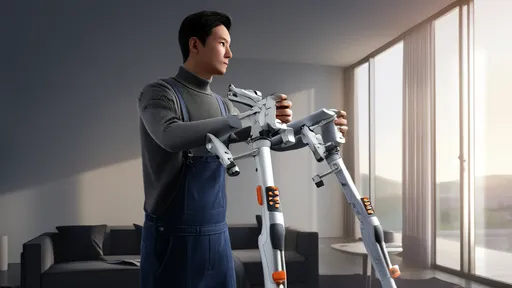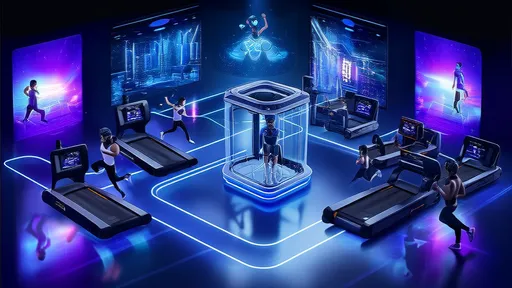The dream of strapping on an exoskeleton and effortlessly lifting heavy objects or walking miles without fatigue has long captured the public imagination. Once confined to military applications and rehabilitation clinics, these robotic assistive devices have slowly trickled into the civilian sector. Yet despite decades of development and occasional flashes of media hype, exoskeletons remain conspicuously absent from mainstream adoption. The barriers to widespread civilian use are as complex as the technology itself.
Cost remains the most immediate hurdle. Even the most basic commercial exoskeletons carry price tags comparable to luxury vehicles, placing them far beyond reach for average consumers. The intricate interplay of actuators, sensors, and control systems requires precision engineering that doesn't come cheap. While military contracts can absorb such expenses, the civilian market lacks comparable funding mechanisms. Some manufacturers have explored rental models or workplace implementations, but these piecemeal approaches haven't solved the fundamental affordability crisis.
Beyond mere pricing, the ergonomic challenges of daily exoskeleton use present another layer of difficulty. Laboratory prototypes may function flawlessly under controlled conditions, but real-world environments introduce countless variables. Stairs, uneven terrain, crowded spaces, and weather conditions all conspire to complicate what seems straightforward in demonstrations. The devices often require careful calibration to individual users, a process too cumbersome for casual adoption. Many models still suffer from limited battery life or excessive weight - solving one physical problem while creating others.
The regulatory landscape forms another invisible barrier. Unlike medical devices that undergo rigorous approval processes or consumer electronics with established safety standards, exoskeletons occupy an awkward middle ground. Liability concerns loom large, particularly for enhancement applications rather than medical necessities. Insurance providers have been slow to develop frameworks for covering exoskeleton-related injuries or malfunctions. This uncertainty discourages both manufacturers from aggressive commercialization and consumers from making substantial investments.
Cultural acceptance may prove the most stubborn obstacle of all. Outside specific industrial or medical contexts, wearing robotic augmentation still carries social stigma. The technology evokes uncomfortable associations with disability or unnatural enhancement that many potential users find off-putting. Unlike smartphones that quickly transitioned from luxury to necessity, exoskeletons lack a clear narrative about why civilians need them in daily life. Marketing efforts have struggled to move beyond niche applications to articulate a compelling vision for ubiquitous use.
Technical limitations continue to hamper progress as well. While exoskeletons excel at repetitive, predictable motions, they struggle with the fluid, adaptive movements required in unstructured environments. The cognitive load of operating many systems outweighs their benefits for short-term tasks. Energy efficiency remains poor compared to biological systems, with most devices requiring frequent recharging for modest performance gains. These engineering challenges resist easy solutions, as they often involve fundamental trade-offs between power, weight, and functionality.
The workforce development pipeline presents another often-overlooked challenge. Widespread adoption would require trained technicians for maintenance and customization, a workforce that currently doesn't exist at scale. Unlike automobiles that developed parallel ecosystems of mechanics and parts suppliers over a century, exoskeletons lack this supporting infrastructure. The scarcity of repair options makes ownership impractical outside institutional settings with dedicated technical staff.
Market fragmentation compounds these issues. With no dominant design paradigm emerging, manufacturers pursue incompatible technical approaches. This lack of standardization means accessories, software, or expertise for one system rarely transfer to another. Consumers face the unsettling prospect of investing in a technology that might become obsolete or unsupported as the industry shakes out. The resulting hesitation slows the feedback loops necessary for iterative improvement.
Perhaps most fundamentally, exoskeletons suffer from an identity crisis in civilian applications. Are they medical devices, productivity tools, lifestyle products, or something else entirely? This confusion manifests in everything from marketing strategies to user interfaces. The technology's military origins continue to influence design priorities in ways that don't always translate well to civilian needs. Without clearer value propositions tailored to specific use cases, exoskeletons risk becoming solutions in search of problems.
Despite these challenges, glimmers of progress appear at the margins. Some construction firms and warehouses have implemented exoskeletons for specific high-strain tasks with measurable success. The aging population in developed countries may drive demand for mobility assistance devices. Advances in materials science and battery technology could address some performance limitations. Yet for now, the vision of exoskeletons becoming as commonplace as bicycles or automobiles remains firmly in the realm of science fiction.
The civilian exoskeleton market finds itself in a classic technological paradox - too developed to abandon, but not mature enough for mass adoption. Breaking this impasse will require simultaneous advances across technical, economic, and social dimensions. Until these pieces fall into place, robotic augmentation will remain the privilege of specialized users rather than the transformative technology its proponents envision.

By /Jul 10, 2025

By /Jul 10, 2025

By /Jul 10, 2025

By /Jul 10, 2025

By /Jul 10, 2025

By /Jul 10, 2025

By /Jul 10, 2025

By /Jul 10, 2025

By /Jul 10, 2025

By /Jul 10, 2025

By /Jul 10, 2025

By /Jul 10, 2025

By /Jul 10, 2025

By /Jul 10, 2025

By /Jul 10, 2025

By /Jul 10, 2025

By /Jul 10, 2025

By /Jul 10, 2025